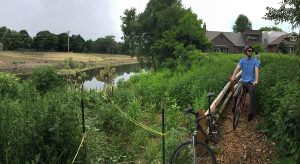Group lays out vision for Cook County waterways
By Jean Lotus Staff Reporter — August 22, 2016
The Our Great Rivers project envisions Chicago’s riverfronts as the city’s next recreational frontier. (Photo courtesy of Our Great Rivers)
Chicago has invested millions in its downtown Riverwalk, but a coalition of Chicago organizations is hoping to make all of the waterways running through Chicago into community treasures by 2040.
Members of the Metropolitan Planning Council and other groups met Aug. 17 with Mayor Rahm Emanuel at the Clark Park Boat House in the 3400 block of North Rockwell St. in the Albany Park neighborhood to unveil the Our Great Rivers project, a plan to improve the areas around and in the three Chicago rivers: the Calumet, Chicago and Des Plaines.
The group met on the future site of the new Riverview pedestrian bridge that will link Clark and California Parks.
“Our experience re-imagining Chicago’s downtown Riverwalk got us thinking about what a new day would look like for entirely different places across our city’s rivers,” said Riverwalk design-team member Carol Ross Barney.
Emanuel called Chicago’s waterways “the City’s next recreational frontier” and said the project would identify ways to invest in the city’s riverfronts to “strengthen and connect neighborhoods and improve the quality of life of all Chicagoans.”
The Our Great Rivers team report says the group held 120 community meetings interviewing residents from areas such as Riverdale, the Sanitary and Ship Canal and Goose Island to create a vision and plan for the development of the three Chicago rivers. Some of the recommendations include improving water quality, expanding river edge open space, promoting bike and pedestrian trails and promoting “neighborhood tourism and entrepreneurship along the waters.”
The plan promotes benchmarks to set goals for 2020, 2030 and 2040.
Goals for 2030 include, “Rivers we can swim in” and for 2040, “Thriving river ecosystems.”
The group studied 155 miles of riverbanks along the three rivers in Chicago learning that the character of the riverfront changes from natural to residential to industrial, the report said.
“People here want to have a personal relationship with the river in locations north and south of downtown, close to their neighborhoods,” the report continued. “They’re looking for a place to bring their family for a picnic, run/walk/bike, fish, read a book, dine or launch a boat. The survey and outreach revealed that in the future, they want the river to be clean and easy to get to, and provide active local destinations with park space.”
The group also studied successful riverfront projects in 10 U.S. cities including Los Angeles, Pittsburg, New Orleans, New York City and closer to home in Aurora, Illinois, Milwaukee and Fort Wayne, Ind.
“Our rivers have come a long way since the days when they were fenced off and polluted with sewage and trash,” said Margaret Frisbie, executive director of Friends of the Chicago River. She said she measured progress by “species of fish, miles of trail and the number of people already out on the water.”
Over the past two years, Friends of the Chicago River worked with the Illinois Department of Natural Resources to release 195,000 juvenile channel catfish into the Chicago and Calumet waterways. The groups also placed 400 cement tubes called “nesting cavities” in the Chicago and Little Calumet rivers. The native fish are a sturdy-enough species to survive the unsanitary conditions of the local rivers and act as a natural cleanup force.
Mariyana Spyropoulos, board president of the Metropolitan Water Reclamation District, said the MWRD was working to create “significant nature-based infrastructure to reduce flooding and opening more of our riverfront land for recreation,” she said. The MWRD has focused on cleaning up the “Collateral Channel” near 31st St. and Kedzie Avenue to help eradicate sewer odors that wafted through the Little Village neighborhood.
Emanuel’s “Building on Burnham” plan also recommends investing in Chicago’s waterfronts including expanding the Riverwalk through the south Loop, the Eleanor Boathouse in Bridgeport and a rails-to-trails project called the Paseo connecting the Little Village and Pilsen neighborhoods. The Active Transportation Alliance has started a project to advocate for a continuous Chicago River trail.
Read the current issue of the Cook County Chronicle
Free digital subscription of the Cook County Chronicle
— Group lays out vision for Cook County waterways —







